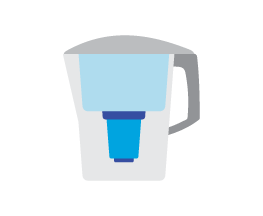
English - Español
According to the EPA, no safe level of lead can be consumed or ingested. Pregnant women, young children, and elderly adults are the most affected by lead exposure. The pregnant mother passes along lead to the baby, which can lead to premature birth and reduced growth. Low levels of lead can create learning disabilities and more issues in children. For adults, high levels of lead can damage kidneys, brain, and the nervous system.
Pregnant women, young children, and elderly adults are most affected by lead exposure.
If you have a lead or galvanized water service line, the lead from your pipe may leach into the water you drink. Humans do not absorb lead through the skin, so you do not need to filter your shower and bath water for lead.
If you are concerned about lead in your drinking water, visit the EPA's Basic Information about Lead in Drinking Water webpage, the New Jersey DOH’s Lead in Drinking Water Fact Sheets [English] [Español], or follow the steps below to reduce your exposure.
How to Reduce Your Exposure to Lead in Your Drinking Water
If you think you may have a lead or galvanized steel water service line, you can take the below steps to decrease your lead exposure:
Replace your lead or galvanized steel water service line. TWW has developed a Lead Service Line Replacement Program to reduce exposure to lead in drinking water by replacing lead service lines in TWW’s service area. To learn more, visit our Home Page.
Run cold water before using. The longer the water stays in the plumbing, the more lead it may have. If the water in the faucet has been sitting for more than 6 hours, run water for 5 minutes before using it. Showering and flushing the toilet also help flush your water line.
Use cold water for cooking, drinking, and making baby formula. Lead dissolves into hot water more easily than cold water. If you need hot water, draw cold water and then heat it. It is safe to shower, wash dishes, and do laundry with hot water from the tap. Lead does not affect humans through the skin. Boiling water does NOT reduce lead.
Check your home's internal plumbing for lead. Potential lead sources include lead pipes, lead-based solder, and brass fixtures and valves (including faucets). When buying new plumbing fixtures (faucets, valves, sinks, hose bibs, etc.), choose those that have zero-content meeting current "lead-free" requirements. Read the labels of new plumbing fixtures closely.
Remove and clean faucet aerators. Every 3 months, remove and clean aerators/screens at the tip of faucets to remove build up.
Remove the faucet aerators/screens from all taps.
Rinse the faucet aerators/screens.
Run the water without the aerator/screen for 3 to 5 minutes.
Replace faucet aerators/screens.
Test your water for lead. Testing is essential because lead cannot be seen, tasted, or smelled in drinking water. If your service lines are eligible for TWW's Lead and Copper Sampling Program you will be notified by mail. Look for the annual letter that informs you about your service line material. You can also test your water for lead using a state-approved laboratory.
Use filters. Be sure the filter you choose (faucet and/or pitcher filter) is approved to reduce lead (NSF 53/42-certified for lead removal). Visit this link to learn more about water filters.
Test your child's blood for lead. Your local doctor or pediatrician can perform a blood test for lead and give you information about the health effects of lead. New Jersey law requires that children be tested for lead in their blood at 1 and 2 years of age and before they are 6 years old if they have never been tested before or if they have been exposed to a known lead source. You can find out more about how to get your child tested and how to pay for it at https://www.nj.gov/health/childhood-lead/.









